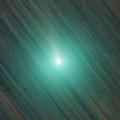
|
Now it is 8.4 mag (Oct. 16, Marek Biely). It will fade out rapidly after this. It stays observable in good condition.
Date(TT) R.A. (2000) Decl. Delta r Elong. m1 Best Time(A, h)
Oct. 28 8 19.23 8 42.5 0.455 1.086 88 7.5 4:51 (327, 60)
Nov. 4 8 34.93 4 0.8 0.480 1.109 90 7.7 4:57 (338, 57)
|
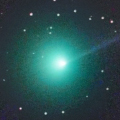
|
Now it is 8.2 mag (Oct. 12, Virgilio Gonano). It will fade out rapidly after this. It will be fainter than 18 mag in January. It will never be observable after this.
Date(TT) R.A. (2000) Decl. Delta r Elong. m1 Best Time(A, h)
Oct. 28 13 45.37 -13 7.7 1.349 0.370 5 7.9 4:51 (277,-13)
Nov. 4 14 38.67 -19 9.9 1.455 0.471 4 8.8 18:29 ( 79,-19)
|

|
It will approach to Earth down to 0.2 a.u. in November, and it is expected to brighten up to 7.5 mag. Now it is 8.5 mag (Oct. 27, Taras Prystavski). It will turn to fade out rapidly after brightening. In the Northern Hemisphere, it will be unobservable in January. But it will be observable again in November. In the Southern Hemisphere, it is not observable now, but it will be observable soon.
Date(TT) R.A. (2000) Decl. Delta r Elong. m1 Best Time(A, h)
Oct. 28 13 20.20 49 50.3 0.539 0.895 63 9.2 4:51 (226, 25)
Nov. 4 15 2.21 48 51.3 0.319 0.901 64 8.1 18:29 (133, 24)
|
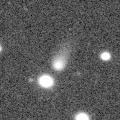
|
It is expected to brighten up to 7 mag in early 2024. Now it is 12.3 mag (Sept. 16, Jose G. S. Aguiar). It will brighten rapidly after this. In the Northern Hemisphere, it will be unobservable soon. It locates somewhat low in the Southern Hemisphere. But it will become high in winter. The brightness evolution slowed down since May.
Date(TT) R.A. (2000) Decl. Delta r Elong. m1 Best Time(A, h)
Oct. 28 11 13.98 -36 36.7 2.622 2.049 45 10.2 4:51 (316, -1)
Nov. 4 11 34.36 -37 34.5 2.543 1.979 45 10.0 4:57 (319, 0)
|

|
Now it is 10.1 mag (Oct. 20, Juan Jose Gonzalez). Fading gradually. In the Northern Hemisphere, it will be unobservable in January. In the Southern Hemisphere, it stays observable in good condition.
Date(TT) R.A. (2000) Decl. Delta r Elong. m1 Best Time(A, h)
Oct. 28 0 19.17 -41 28.0 2.322 2.950 120 10.5 21:52 ( 0, 14)
Nov. 4 0 3.36 -42 24.7 2.472 3.000 112 10.7 21:09 ( 0, 13)
|
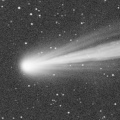
|
It approached to Sun down to 0.23 a.u. and brightened up to 2.5 mag in mid September (Sept. 18, Juan Jose Gonzalez). Now it is 9.7 mag (Oct. 26, Martin Masek). Fading rapidly. It will be fainter than 18 mag in January. In the Northern Hemisphere, it is not observable now, but it will be observable soon. In the Southern Hemisphere, it will be getting higher gradually.
Date(TT) R.A. (2000) Decl. Delta r Elong. m1 Best Time(A, h)
Oct. 28 12 55.50 -29 54.9 1.944 1.109 23 11.2 4:51 (298,-13)
Nov. 4 12 55.05 -32 42.9 2.027 1.250 28 12.2 4:57 (304, -9)
|
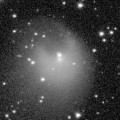
|
It returns for the first time in 70 years. It will brighten up to 4.5 mag in 2024 spring. It suddenly brightened in outburst by 5 mag up to 11.5 mag on July 20 (E. Tamas, Francois Kugel). It brightened again in another outburst up to 11.7 mag on Oct. 5 (Richard Miles). Now it is 11.8 mag (Oct. 22, Osamu Miyazaki). It will brighten rapidly after this. In the Northern Hemisphere, it will be getting lower gradually. In the Southern Hemisphere, it is not observable now.
Date(TT) R.A. (2000) Decl. Delta r Elong. m1 Best Time(A, h)
Oct. 28 17 37.91 42 23.7 2.915 2.798 73 11.3 18:35 (116, 50)
Nov. 4 17 45.54 41 25.0 2.858 2.715 71 11.3 18:29 (115, 48)
|

|
It is expected to brighten up to 7 mag, and it will be observable in good condition in winter. Now it is 12.2 mag (Oct. 26, Osamu Miyazaki). Brightening rapidly. In the Northern Hemisphere, it stays observable in good condition. It locates somewhat low in the Southern Hemisphere. But it will become high in winter.
Date(TT) R.A. (2000) Decl. Delta r Elong. m1 Best Time(A, h)
Oct. 28 7 32.65 21 47.2 0.848 1.439 102 12.4 4:51 (342, 76)
Nov. 4 7 58.34 21 27.1 0.785 1.403 103 11.4 4:57 (350, 76)
|

|
It brightened up to 8 mag from 2022 summer to 2023 spring. Now it is 12.5 mag (Oct. 26, Osamu Miyazaki). Fading slowly. It stays observable in good condition.
Date(TT) R.A. (2000) Decl. Delta r Elong. m1 Best Time(A, h)
Oct. 28 6 41.03 -8 11.0 3.601 4.032 108 12.2 4:18 ( 0, 47)
Nov. 4 6 36.36 -8 2.1 3.566 4.095 115 12.2 3:46 ( 0, 47)
|

|
It brightened up to 7.8 mag in late July (July 20, Thomas Lehmann). Now it is 12.9 mag (Oct. 3, Chris Wyatt). Fading slowly. Now it is not observable. It will appear soon in the Northern Hemisphere, or in December in the Southern Hemisphere.
Date(TT) R.A. (2000) Decl. Delta r Elong. m1 Best Time(A, h)
Oct. 28 15 1.22 -11 12.4 2.873 1.920 13 12.6 18:35 ( 81, -6)
Nov. 4 15 3.69 -10 44.0 2.955 1.979 8 12.8 18:29 ( 84,-10)
|
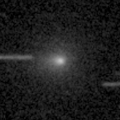
|
Now it is 12.8 mag (Oct. 17, Ken-ichi Kadota). It will fade out rapidly after this. In the Northern Hemisphere, it stays observable in good condition. It locates somewhat low in the Southern Hemisphere.
Date(TT) R.A. (2000) Decl. Delta r Elong. m1 Best Time(A, h)
Oct. 28 18 1.43 -5 5.3 1.205 1.087 58 12.8 18:35 ( 55, 32)
Nov. 4 18 36.55 -4 32.1 1.195 1.115 60 12.9 18:29 ( 53, 35)
|

|
Now it is 14.3 mag (Oct. 16, Martin Masek). It stays 13 mag for a while. It stays extremely low in the Northern Hemisphere. In the Southern Hemisphere, it stays observable in good condition.
Date(TT) R.A. (2000) Decl. Delta r Elong. m1 Best Time(A, h)
Oct. 28 10 46.30 -26 48.2 4.675 4.091 48 13.2 4:51 (314, 10)
Nov. 4 10 45.97 -28 24.7 4.622 4.120 54 13.2 4:57 (321, 14)
|

|
Now it is 12.1 mag (Oct. 15, Hiroshi Abe). In the Northern Hemisphere, it stays observable in good condition. It locates somewhat low in the Southern Hemisphere.
Date(TT) R.A. (2000) Decl. Delta r Elong. m1 Best Time(A, h)
Oct. 28 8 40.35 20 50.0 6.120 6.148 86 13.8 4:51 (301, 66)
Nov. 4 8 42.05 20 42.0 6.009 6.150 93 13.8 4:57 (317, 71)
|
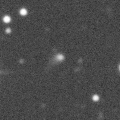
|
Now it is 14.2 mag (Oct. 19, Ken-ichi Kadota). Brightening slowly. In the Northern Hemisphere, it stays observable in good condition. In the Southern Hemisphere, it will be getting higher gradually. It is expected to brighten up to 12 mag from 2024 to 2025.
Date(TT) R.A. (2000) Decl. Delta r Elong. m1 Best Time(A, h)
Oct. 28 9 43.07 5 10.4 4.913 4.632 67 14.0 4:51 (302, 44)
Nov. 4 9 43.19 5 32.8 4.753 4.596 74 13.9 4:57 (311, 50)
|

|
It brightened up to 8.3 mag in 2021-2022 winter (Jan. 6, 2022, Toshiyuki Takahashi). Now it is 13.2 mag (July 14, Chris Wyatt). It stays 14 mag for a while. In the Northern Hemisphere, it is not observable now, but it will be observable soon. In the Southern Hemisphere, it stays observable in good condition.
Date(TT) R.A. (2000) Decl. Delta r Elong. m1 Best Time(A, h)
Oct. 28 11 6.76 -40 32.9 7.232 6.610 48 13.9 4:51 (320, -3)
Nov. 4 11 10.96 -41 31.2 7.234 6.655 50 13.9 4:57 (325, 0)
|

|
Now it is 14.0 mag (Oct. 14, Chris Wyatt). Fading slowly. In the Northern Hemisphere, it is not observable now. In the Southern Hemisphere, it stays observable in good condition. It was expected to brighten up to 10 mag from spring to summer. However, it was fainter than originally expected.
Date(TT) R.A. (2000) Decl. Delta r Elong. m1 Best Time(A, h)
Oct. 28 12 3.40 -78 42.6 3.753 3.496 67 14.2 4:51 (348,-31)
Nov. 4 12 3.23 -79 54.6 3.796 3.529 67 14.2 4:57 (350,-30)
|
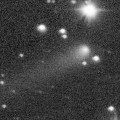
|
Now it is 14.3 mag (Oct. 12, Hiroshi Abe). Fading slowly. It will be getting lower gradually after this, and it will be unobservable in January in the Southern Hemisphere, or in February in the Northern Hemisphere.
Date(TT) R.A. (2000) Decl. Delta r Elong. m1 Best Time(A, h)
Oct. 28 23 21.62 4 8.6 2.743 3.547 138 14.2 20:55 ( 0, 59)
Nov. 4 23 9.55 3 44.0 2.872 3.574 128 14.3 20:16 ( 0, 59)
|
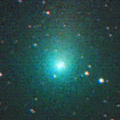
|
It brightened up to 9.5 mag from last winter to early spring (Jan. 30, Katsumi Yoshimoto). Now it is 13.9 mag (Oct. 17, Osamu Miyazaki). It will fade out rapidly after this. It will be getting lower gradually after this, and it will be unobservable in February.
Date(TT) R.A. (2000) Decl. Delta r Elong. m1 Best Time(A, h)
Oct. 28 22 37.62 -6 49.4 2.822 3.482 124 14.3 20:12 ( 0, 48)
Nov. 4 22 34.83 -8 26.1 2.995 3.546 116 14.6 19:42 ( 0, 47)
|
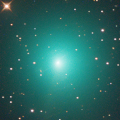
|
It brightened up to 8.4 mag in late July (July 22, Thomas Lehmann). Now it is 12.8 mag (Oct. 15, Thomas Lehmann). Fading rapidly. It will be fainter than 18 mag in December. It stays observable in good condition.
Date(TT) R.A. (2000) Decl. Delta r Elong. m1 Best Time(A, h)
Oct. 28 22 47.46 -25 18.1 1.400 2.065 118 14.4 20:22 ( 0, 30)
Nov. 4 22 54.36 -25 27.8 1.556 2.146 112 14.9 20:02 ( 0, 30)
|

|
The ATLAS search program detected its cometary activity in April. It continues to be brightening even after the perihelion passage. Now it is 14.4 mag (Oct. 14, Chris Wyatt). It will fade out rapidly after this. It will be fainter than 18 mag in January. It stays observable in good condition.
Date(TT) R.A. (2000) Decl. Delta r Elong. m1 Best Time(A, h)
Oct. 28 23 30.88 -24 5.6 2.548 3.244 126 14.5 21:05 ( 0, 31)
Nov. 4 23 31.13 -23 7.6 2.657 3.282 121 14.7 20:38 ( 0, 32)
|
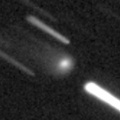
|
Now it is 14.9 mag (Sept. 18, Ken-ichi Kadota). Brightening slowly. Now it is not observable. It will appear in December. It is expected to brighten up to 12.5 mag in 2024 spring. At the high light, it will be observable in excellent condition in the Southern Hemisphere, but it will be low in the Northern Hemisphere.
Date(TT) R.A. (2000) Decl. Delta r Elong. m1 Best Time(A, h)
Oct. 28 15 12.92 -5 59.8 3.974 3.042 17 14.6 18:35 ( 83, -1)
Nov. 4 15 15.00 -7 17.0 3.969 3.009 12 14.6 18:29 ( 85, -6)
|
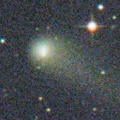
|
It brightened up to 11.1 mag in early 2022 (Mar. 31, 2022, F. Kugel, J.-G. Bosch, J. Nicolas). Now it is 14.3 mag (Oct. 15, Thomas Lehmann). It stays 15 mag for a while. It locates somewhat low in the Northern Hemisphere. But it will become high in winter. In the Southern Hemisphere, it is not observable now, but it will appear in February.
Date(TT) R.A. (2000) Decl. Delta r Elong. m1 Best Time(A, h)
Oct. 28 16 6.35 15 58.9 6.595 5.885 41 14.8 18:35 ( 94, 22)
Nov. 4 16 12.19 15 49.4 6.656 5.922 39 14.9 18:29 ( 96, 19)
|
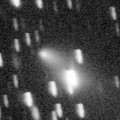
|
It brightened up to 13.6 mag in summer (July 16, Mitsunori Tsumura). Now it is 15.0 mag (Oct. 23, Ken-ichi Kadota). It will fade out rapidly after this. It will be fainter than 18 mag in February. In the Northern Hemisphere, it stays observable in good condition. In the Southern Hemisphere, it will never be observable after this.
Date(TT) R.A. (2000) Decl. Delta r Elong. m1 Best Time(A, h)
Oct. 28 0 21.77 70 41.8 1.423 2.103 119 14.8 21:54 (180, 54)
Nov. 4 23 55.78 70 32.7 1.474 2.145 119 15.0 21:01 (180, 54)
|

|
Now it is 15.2 mag (July 22, ATLAS Chile). It stays 14 mag for a while. It stays extremely low in the Northern Hemisphere. In the Southern Hemisphere, it will be getting higher gradually.
Date(TT) R.A. (2000) Decl. Delta r Elong. m1 Best Time(A, h)
Oct. 28 11 21.46 -31 30.2 6.235 5.540 42 14.9 4:51 (311, 2)
Nov. 4 11 27.74 -32 6.7 6.166 5.517 45 14.9 4:57 (316, 5)
|

|
It will fade out rapidly after this. It will be fainter than 18 mag in January. In the Northern Hemisphere, it will be getting higher gradually. In the Southern Hemisphere, it is not observable now, but it will be observable soon.
Date(TT) R.A. (2000) Decl. Delta r Elong. m1 Best Time(A, h)
Oct. 28 15 21.48 -11 50.9 0.934 0.311 18 14.9 18:35 ( 77, -2)
Nov. 4 16 35.13 -8 26.2 0.817 0.502 30 15.7 18:29 ( 72, 11)
|
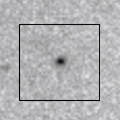
|
It is expected to brighten up to 8.5 mag from January to February. Now it is 17.2 mag (Oct. 24, Taras Prystavski). Brightening rapidly. It stays observable in good condition. It is much fainter than this ephemeris recently.
Date(TT) R.A. (2000) Decl. Delta r Elong. m1 Best Time(A, h)
Oct. 28 3 1.30 20 47.2 0.744 1.723 164 15.4 0:39 ( 0, 76)
Nov. 4 2 59.01 20 13.4 0.693 1.681 172 14.9 0:10 ( 0, 75)
|

|
It is expected to brighten up to 14.5 mag in winter. Now it is 15.5 mag (Oct. 17, Hirohisa Sato). It stays 15 mag for a while. It stays observable in good condition.
Date(TT) R.A. (2000) Decl. Delta r Elong. m1 Best Time(A, h)
Oct. 28 3 23.26 15 53.9 1.569 2.530 161 15.3 1:01 ( 0, 71)
Nov. 4 3 18.08 16 4.5 1.515 2.496 169 15.2 0:29 ( 0, 71)
|

|
It will approach to Sun down to 0.4 a.u. in late September in 2024, and it is expected to brighten up to 0 mag. Now it is 15.3 mag (Sept. 10, A. Ivanov et al.). Brightening gradually. Now it is not observable. It will appear soon in the Northern Hemisphere, or in December in the Southern Hemisphere. At the high light, in the Northern Hemisphere, it will be observable in good condition after the perihelion passage. In the Southern Hemisphere, it will be observable in the low sky before and after the perihelion passage.
Date(TT) R.A. (2000) Decl. Delta r Elong. m1 Best Time(A, h)
Oct. 28 14 27.01 -3 47.8 5.929 4.954 10 15.3 18:35 ( 92, -9)
Nov. 4 14 30.68 -4 16.1 5.851 4.881 10 15.2 4:57 (267,-11)
|

|
David Rankin detected its cometary activity in June. Now it is 15.5 mag (Oct. 13, Michael Jager). Fading slowly. In the Northern Hemisphere, it stays observable in good condition. In the Southern Hemisphere, it will be getting lower gradually.
Date(TT) R.A. (2000) Decl. Delta r Elong. m1 Best Time(A, h)
Oct. 28 22 12.20 -4 1.5 1.514 2.181 119 15.6 19:47 ( 0, 51)
Nov. 4 22 17.40 -3 43.7 1.568 2.167 113 15.6 19:25 ( 0, 51)
|

|
It has not been observed yet in this apparition. It was expected to brighten rapidly up to 15 mag in summer. But actually, it is not detected, fainter than 18 mag (Oct. 14, Martin Masek). Fading slowly. It will be unobservable in January in the Southern Hemisphere, or in February in the Northern Hemisphere.
Date(TT) R.A. (2000) Decl. Delta r Elong. m1 Best Time(A, h)
Oct. 28 18 56.78 -22 51.0 2.108 1.983 69 15.6 18:35 ( 31, 25)
Nov. 4 19 12.17 -21 58.1 2.171 1.981 65 15.6 18:29 ( 33, 25)
|

|
It is expected to brighten up to 14 mag in 2024 summer. At the high light, it is not observable in the Northern Hemisphere. Now it is 16.3 mag (Oct. 17, Yukihiro Sugiyama). It stays 15 mag for a while. In the Southern Hemisphere, it stays observable in good condition.
Date(TT) R.A. (2000) Decl. Delta r Elong. m1 Best Time(A, h)
Oct. 28 2 55.54 -17 10.4 2.950 3.827 147 15.7 0:34 ( 0, 38)
Nov. 4 2 46.99 -19 26.8 2.923 3.781 145 15.6 23:52 ( 0, 35)
|

|
Now it is 14.3 mag (July 7, Thomas Lehmann). It stays 16 mag for a while. In the Northern Hemisphere, it is not observable now, but it will appear in January. It locates somewhat low in the Southern Hemisphere. But it will become high in winter.
Date(TT) R.A. (2000) Decl. Delta r Elong. m1 Best Time(A, h)
Oct. 28 13 53.68 -49 16.8 3.658 2.920 36 15.6 4:51 (311,-32)
Nov. 4 14 9.88 -49 11.8 3.740 2.976 34 15.7 4:57 (312,-29)
|

|
It is expected to brighten up to 15 mag from autumn to winter. Now it is 16.2 mag (Oct. 26, ATLAS South Africa). It stays 16 mag for a while. In the Northern Hemisphere, it will be getting higher gradually. In the Southern Hemisphere, it stays observable in good condition.
Date(TT) R.A. (2000) Decl. Delta r Elong. m1 Best Time(A, h)
Oct. 28 1 14.81 -52 1.6 1.218 1.861 114 15.8 22:47 ( 0, 3)
Nov. 4 1 1.25 -48 30.5 1.211 1.842 113 15.7 22:07 ( 0, 7)
|
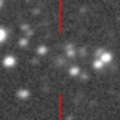
|
Now it is 16.8 mag (Oct. 16, ATLAS South Africa). Fading slowly. It will be unobservable in January.
Date(TT) R.A. (2000) Decl. Delta r Elong. m1 Best Time(A, h)
Oct. 28 19 0.24 -34 37.0 3.173 2.968 69 15.8 18:35 ( 25, 15)
Nov. 4 19 11.21 -34 35.9 3.266 2.978 64 15.9 18:29 ( 27, 14)
|

|
It approached to Earth down to 0.29 a.u. in early February, and it brightened up to 4.5 mag (Feb. 1, Juan Jose Gonzalez). Now it is 16.1 mag (Oct. 4, ATLAS Chile). Fading slowly. In the Northern Hemisphere, it will never be observable after this. In the Southern Hemisphere, it stays observable in good condition.
Date(TT) R.A. (2000) Decl. Delta r Elong. m1 Best Time(A, h)
Oct. 28 6 3.42 -57 17.0 3.775 3.983 94 15.9 3:40 ( 0, -2)
Nov. 4 5 50.13 -59 4.2 3.833 4.056 95 16.0 3:00 ( 0, -4)
|
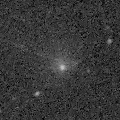
|
Very large comet. It is expected to brighten up to 13 mag in 2031. Now it is 15.9 mag (Oct. 15, Thomas Lehmann). It stays 16 mag for a while. In the Northern Hemisphere, it is not observable now. In the Southern Hemisphere, it stays observable in good condition. In the Northern Hemisphere, it is not observable until 2030.
Date(TT) R.A. (2000) Decl. Delta r Elong. m1 Best Time(A, h)
Oct. 28 3 20.77 -65 35.8 16.872 17.078 100 16.1 0:58 ( 0,-11)
Nov. 4 3 17.76 -65 47.6 16.876 17.054 98 16.1 0:27 ( 0,-11)
|

|
Now it is 15.2 mag (Oct. 17, Ken-ichi Kadota). Fading slowly. It stays observable in good condition.
Date(TT) R.A. (2000) Decl. Delta r Elong. m1 Best Time(A, h)
Oct. 28 0 9.23 -8 37.2 2.893 3.740 143 16.2 21:43 ( 0, 47)
Nov. 4 0 6.63 -8 32.8 2.974 3.756 136 16.3 21:13 ( 0, 47)
|
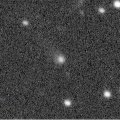
|
Now it is 16.7 mag (Oct. 18, ATLAS South Africa). It stays 16 mag for a while. In the Northern Hemisphere, it will be unobservable soon. In the Southern Hemisphere, it stays observable in good condition.
Date(TT) R.A. (2000) Decl. Delta r Elong. m1 Best Time(A, h)
Oct. 28 9 40.85 -44 2.1 4.034 3.713 64 16.2 4:51 (335, 4)
Nov. 4 9 41.81 -46 47.2 3.982 3.717 67 16.2 4:57 (341, 4)
|

|
It brightened up to 11.8 mag in summer (June 17, Osamu Miyazaki). Now it is 15.4 mag (Oct. 10, Masayoshi Yoshimi). It will fade out rapidly after this. It will be fainter than 18 mag in December. In the Northern Hemisphere, it stays observable in good condition. In the Southern Hemisphere, it will be getting lower gradually.
Date(TT) R.A. (2000) Decl. Delta r Elong. m1 Best Time(A, h)
Oct. 28 20 21.43 -3 11.9 2.100 2.367 92 16.5 18:35 ( 15, 51)
Nov. 4 20 31.20 -3 11.1 2.206 2.394 88 16.8 18:29 ( 20, 50)
|

|
It brightened up to 14.1 mag in 2022 spring (Mar. 22, 2022, Chris Wyatt). Now it is 16.0 mag (Oct. 23, ATLAS Chile). Fading slowly. It stays observable in good condition.
Date(TT) R.A. (2000) Decl. Delta r Elong. m1 Best Time(A, h)
Oct. 28 2 2.85 -2 29.1 4.537 5.502 164 16.5 23:36 ( 0, 53)
Nov. 4 1 55.77 -2 20.3 4.606 5.550 160 16.5 23:02 ( 0, 53)
|
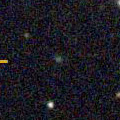
|
Now it is 17.2 mag (Oct. 17, ATLAS-HKO, Haleakala). It stays 17 mag for a while. In the Northern Hemisphere, it stays observable in good condition. It stays extremely low in the Southern Hemisphere.
Date(TT) R.A. (2000) Decl. Delta r Elong. m1 Best Time(A, h)
Oct. 28 5 0.82 40 57.0 5.988 6.703 132 16.7 2:39 (180, 84)
Nov. 4 4 59.22 41 12.5 5.918 6.701 139 16.7 2:10 (180, 84)
|

|
Now it is 16.4 mag (Oct. 17, Ken-ichi Kadota). It stays 17 mag for a while. It stays observable in good condition.
Date(TT) R.A. (2000) Decl. Delta r Elong. m1 Best Time(A, h)
Oct. 28 4 56.59 -12 18.9 6.653 7.343 130 16.8 2:34 ( 0, 43)
Nov. 4 4 54.92 -12 31.5 6.570 7.312 135 16.7 2:05 ( 0, 43)
|
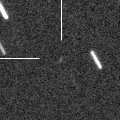
|
Now it is 17.7 mag (July 12, A. Diepvens). It stays 16 mag for a while. In the Northern Hemisphere, it will be getting higher gradually. In the Southern Hemisphere, it is not observable now, but it will be observable soon.
Date(TT) R.A. (2000) Decl. Delta r Elong. m1 Best Time(A, h)
Oct. 28 11 52.78 11 43.4 2.703 2.064 41 16.8 4:51 (272, 23)
Nov. 4 11 54.20 9 11.5 2.617 2.064 46 16.7 4:57 (279, 28)
|

|
Very far object. Now it is 16.6 mag (Oct. 18, ATLAS South Africa). It stays 17 mag for a while. In the Northern Hemisphere, it is not observable now. In the Southern Hemisphere, it stays observable in good condition.
Date(TT) R.A. (2000) Decl. Delta r Elong. m1 Best Time(A, h)
Oct. 28 4 52.01 -76 49.7 10.315 10.313 87 16.8 2:28 ( 0,-22)
Nov. 4 4 37.01 -77 9.8 10.335 10.313 85 16.8 1:45 ( 0,-22)
|
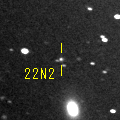
|
It is expected to brighten up to 11.5 mag in 2025 autumn, and it will be observable in good condition. Now it is 17.0 mag (Sept. 22, ATLAS South Africa). It stays 16 mag for a while. It will be getting lower gradually after this, and it will be unobservable in January.
Date(TT) R.A. (2000) Decl. Delta r Elong. m1 Best Time(A, h)
Oct. 28 20 34.38 -19 13.1 6.448 6.560 92 16.8 18:35 ( 8, 36)
Nov. 4 20 36.06 -19 3.8 6.519 6.517 85 16.8 18:29 ( 13, 35)
|
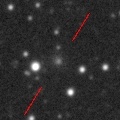
|
Now it is 16.4 mag (Oct. 15, Yukihiro Sugiyama). It stays 17 mag for a while. It will be getting lower gradually after this, and it will be unobservable in January in the Northern Hemisphere, or in December in the Southern Hemisphere.
Date(TT) R.A. (2000) Decl. Delta r Elong. m1 Best Time(A, h)
Oct. 28 18 49.53 -12 35.2 2.643 2.462 68 16.9 18:35 ( 39, 33)
Nov. 4 19 0.67 -12 31.7 2.707 2.449 64 16.9 18:29 ( 41, 32)
|

|
Now it is 16.9 mag (Oct. 6, Ken-ichi Kadota). Fading slowly. It will be fainter than 18 mag in January. In the Southern Hemisphere, it will be getting lower gradually. It was very faint as 21.5 mag in 2021. It seems to be bright temporarily in outburst.
Date(TT) R.A. (2000) Decl. Delta r Elong. m1 Best Time(A, h)
Oct. 28 21 9.10 -11 51.4 4.307 4.619 102 16.9 18:44 ( 0, 43)
Nov. 4 21 11.31 -11 42.8 4.428 4.633 95 17.1 18:29 ( 3, 43)
|
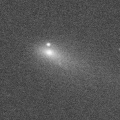
|
It brightened up to 12.8 mag in spring (Mar. 8, Taras Prystavski). Now it is 17.0 mag (Oct. 19, Ken-ichi Kadota). It will fade out rapidly after this. It will be fainter than 18 mag soon. It stays observable in good condition.
Date(TT) R.A. (2000) Decl. Delta r Elong. m1 Best Time(A, h)
Oct. 28 0 40.71 -6 7.6 1.873 2.786 151 16.9 22:15 ( 0, 49)
Nov. 4 0 36.36 -5 60.0 1.960 2.823 143 17.2 21:43 ( 0, 49)
|

|
Now it is 16.4 mag (Oct. 25, ATLAS Chile). Fading slowly. It will be fainter than 18 mag in January. It stays observable in good condition.
Date(TT) R.A. (2000) Decl. Delta r Elong. m1 Best Time(A, h)
Oct. 28 3 51.34 5 23.0 2.185 3.105 153 17.0 1:29 ( 0, 60)
Nov. 4 3 47.24 4 57.7 2.169 3.117 159 17.0 0:58 ( 0, 60)
|

|
Now it is 17.3 mag (Oct. 12, ATLAS Chile). Fading slowly. It will be fainter than 18 mag in December. It locates somewhat low in the Northern Hemisphere. In the Southern Hemisphere, it will be getting lower gradually after this, and it will be unobservable in December.
Date(TT) R.A. (2000) Decl. Delta r Elong. m1 Best Time(A, h)
Oct. 28 18 17.55 -22 7.0 3.466 3.093 60 17.0 18:35 ( 40, 21)
Nov. 4 18 27.02 -22 6.5 3.587 3.131 55 17.2 18:29 ( 43, 20)
|

|
Now it is 17.4 mag (Oct. 17, D. Buczynski). It stays 17 mag for a while. In the Northern Hemisphere, it stays observable in good condition. It locates somewhat low in the Southern Hemisphere.
Date(TT) R.A. (2000) Decl. Delta r Elong. m1 Best Time(A, h)
Oct. 28 5 8.70 38 38.6 4.557 5.277 132 17.1 2:47 (180, 86)
Nov. 4 5 6.91 38 23.8 4.465 5.256 139 17.1 2:17 (180, 87)
|
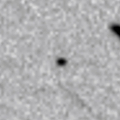
|
Now it is 18.3 mag (Oct. 13, Toshiyuki Takahashi). It will brighten rapidly after this. It stays observable in good condition.
Date(TT) R.A. (2000) Decl. Delta r Elong. m1 Best Time(A, h)
Oct. 28 0 13.52 0 7.1 0.715 1.649 149 17.4 21:47 ( 0, 55)
Nov. 4 0 5.25 -2 16.6 0.687 1.578 139 17.2 21:11 ( 0, 53)
|
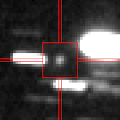
|
It is expected to brighten up to 12.5 mag in 2024 summer. Now it is 17.3 mag (July 28, ATLAS South Africa). Brightening slowly. In the Northern Hemisphere, it is not observable now. In the Southern Hemisphere, it will be getting higher gradually. Around the high light, it is observable in good condition in the Southern Hemisphere, but it locates very low in the Northern Hemisphere.
Date(TT) R.A. (2000) Decl. Delta r Elong. m1 Best Time(A, h)
Oct. 28 12 33.24 -48 20.5 5.338 4.627 40 17.3 4:51 (316,-19)
Nov. 4 12 43.24 -49 20.7 5.274 4.572 41 17.2 4:57 (319,-17)
|
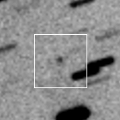
|
Now it is 17.4 mag (Oct. 23, Ken-ichi Kadota). It stays 17 mag for a while. In the Northern Hemisphere, it stays observable in good condition. In the Southern Hemisphere, it will be unobservable soon.
Date(TT) R.A. (2000) Decl. Delta r Elong. m1 Best Time(A, h)
Oct. 28 23 55.00 56 12.3 3.682 4.385 129 17.2 21:28 (180, 69)
Nov. 4 23 37.06 54 45.5 3.691 4.369 127 17.2 20:43 (180, 70)
|

|
Now it is 17.2 mag (Oct. 26, ATLAS South Africa). It stays 17 mag for a while. It stays extremely low in the Northern Hemisphere. In the Southern Hemisphere, it stays observable in good condition.
Date(TT) R.A. (2000) Decl. Delta r Elong. m1 Best Time(A, h)
Oct. 28 5 14.69 -39 40.3 7.493 7.916 111 17.4 2:52 ( 0, 15)
Nov. 4 5 13.23 -40 7.3 7.442 7.891 113 17.3 2:23 ( 0, 15)
|
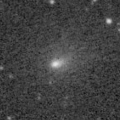
|
Now it is 16.7 mag (Sept. 5, Thomas Lehmann). Fading gradually. It will be fainter than 18 mag soon. It stays extremely low in the Northern Hemisphere. In the Southern Hemisphere, it will be getting lower gradually.
Date(TT) R.A. (2000) Decl. Delta r Elong. m1 Best Time(A, h)
Oct. 28 19 7.00 -33 58.4 2.368 2.242 70 17.4 18:35 ( 24, 16)
Nov. 4 19 13.42 -35 17.0 2.549 2.312 64 17.7 18:29 ( 26, 14)
|

|
The cometary activity was detected by Masayoshi Yoshimi on Sept. 15. Now it is 16.0 mag (Sept. 15, Masayoshi Yoshimi). It will fade out rapidly after this. It will be fainter than 18 mag soon. In the Northern Hemisphere, it stays observable in good condition. In the Southern Hemisphere, it will never be observable after this.
Date(TT) R.A. (2000) Decl. Delta r Elong. m1 Best Time(A, h)
Oct. 28 21 38.48 57 2.1 0.281 1.134 113 17.4 19:14 (180, 68)
Nov. 4 22 0.08 61 15.8 0.302 1.146 113 17.5 19:08 (180, 63)
|
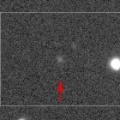
|
It will be observable at 15-16 mag from 2024 to 2025. Now it is 17.9 mag (Apr. 25, A. Diepvens). Brightening slowly. In the Northern Hemisphere, it will be getting higher gradually. In the Southern Hemisphere, it is not observable now, but it will be observable soon.
Date(TT) R.A. (2000) Decl. Delta r Elong. m1 Best Time(A, h)
Oct. 28 12 8.27 7 1.7 4.673 3.907 35 17.5 4:51 (274, 17)
Nov. 4 12 15.47 6 18.8 4.593 3.892 40 17.5 4:57 (278, 22)
|
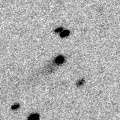
|
Now it is 17.0 mag (Apr. 11, Michael Jager). It stays 18 mag for a while. In the Northern Hemisphere, it will be getting higher gradually. In the Southern Hemisphere, it is not observable now, but it will be observable soon.
Date(TT) R.A. (2000) Decl. Delta r Elong. m1 Best Time(A, h)
Oct. 28 12 29.68 12 28.0 10.023 9.227 34 17.6 4:51 (266, 16)
Nov. 4 12 30.82 12 29.6 9.962 9.238 41 17.6 4:57 (271, 23)
|
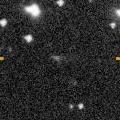
|
First return of a new periodic comet which brightened up to 15 mag in 2008. Now it is 18.1 mag (Oct. 5, Ken-ichi Kadota). It will fade out rapidly after this. It will be fainter than 18 mag soon. It stays observable in good condition.
Date(TT) R.A. (2000) Decl. Delta r Elong. m1 Best Time(A, h)
Oct. 28 4 2.99 10 54.0 1.841 2.756 151 17.9 1:41 ( 0, 66)
Nov. 4 3 58.98 9 25.9 1.840 2.787 158 18.0 1:09 ( 0, 65)
|
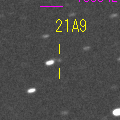
|
Now it is 18.9 mag (Sept. 25, W. Hasubick). It stays 18 mag for a while. It stays observable in good condition.
Date(TT) R.A. (2000) Decl. Delta r Elong. m1 Best Time(A, h)
Oct. 28 7 39.10 10 29.6 7.545 7.763 99 17.9 4:51 (345, 65)
Nov. 4 7 36.24 10 16.2 7.422 7.762 106 17.9 4:46 ( 0, 65)
|

|
First return of a new periodic comet which brightened up to 10 mag in 2001. It is expected to brighten up to 12-13 mag from February to March in 2024. It will brighten rapidly after this. In the Northern Hemisphere, it will be getting higher gradually. In the Southern Hemisphere, it will be getting lower gradually after this, and it will be unobservable in January.
Date(TT) R.A. (2000) Decl. Delta r Elong. m1 Best Time(A, h)
Oct. 28 23 53.23 -43 30.9 1.458 2.092 115 18.0 21:26 ( 0, 12)
Nov. 4 23 38.16 -40 6.9 1.451 2.033 111 17.9 20:44 ( 0, 15)
|

|
Now it is 18.6 mag (Oct. 23, D. Buczynski). It stays 18 mag for a while. It stays observable in good condition.
Date(TT) R.A. (2000) Decl. Delta r Elong. m1 Best Time(A, h)
Oct. 28 5 8.50 25 18.8 3.364 4.133 135 18.0 2:46 ( 0, 80)
Nov. 4 5 6.13 25 7.9 3.296 4.133 143 17.9 2:16 ( 0, 80)
|

|
It brightened up to 14 mag from 2020 to 2021. Now it is 18.0 mag (Oct. 23, Jean-Claude Merlin). Fading slowly. It will be fainter than 18 mag soon. It stays observable in good condition.
Date(TT) R.A. (2000) Decl. Delta r Elong. m1 Best Time(A, h)
Oct. 28 2 49.72 2 45.1 3.818 4.786 165 17.9 0:28 ( 0, 58)
Nov. 4 2 45.30 2 33.4 3.824 4.796 167 18.0 23:51 ( 0, 58)
|

|
It returned for the first time in 68 years. It will brighten up to 7.5 mag in 2024 summer. Now it is 18.8 mag (Oct. 18, Ken-ichi Kadota). It will brighten rapidly after this. It stays observable in good condition. At the high light, it locates low in the Northern Hemisphere, or it is not observable in the Southern Hemisphere.
Date(TT) R.A. (2000) Decl. Delta r Elong. m1 Best Time(A, h)
Oct. 28 4 15.15 -20 38.5 2.617 3.384 134 18.2 1:53 ( 0, 34)
Nov. 4 4 9.07 -21 4.4 2.519 3.314 136 18.0 1:19 ( 0, 34)
|
|
![]()
 144P/Kushida
144P/Kushida 32P/Comas Sola
32P/Comas Sola C/2023 A3 ( Tsuchinshan-ATLAS )
C/2023 A3 ( Tsuchinshan-ATLAS ) 471P/2023 KF3
471P/2023 KF3 213P/Van Ness
213P/Van Ness C/2022 S4 ( Lemmon )
C/2022 S4 ( Lemmon ) C/2021 Y1 ( ATLAS )
C/2021 Y1 ( ATLAS ) 226P/Pigott-LINEAR-Kowalski
226P/Pigott-LINEAR-Kowalski 199P/Shoemaker 4
199P/Shoemaker 4 C/2022 E3 ( ZTF )
C/2022 E3 ( ZTF ) C/2014 UN271 ( Bernardinelli-Bernstein )
C/2014 UN271 ( Bernardinelli-Bernstein ) 117P/Helin-Roman-Alu 1
117P/Helin-Roman-Alu 1 C/2022 A3 ( Lemmon-ATLAS )
C/2022 A3 ( Lemmon-ATLAS ) 237P/LINEAR
237P/LINEAR C/2020 Y2 ( ATLAS )
C/2020 Y2 ( ATLAS ) C/2021 S4 ( Tsuchinshan )
C/2021 S4 ( Tsuchinshan ) C/2022 QE78 ( ATLAS )
C/2022 QE78 ( ATLAS ) C/2022 V2 ( Lemmon )
C/2022 V2 ( Lemmon ) C/2019 E3 ( ATLAS )
C/2019 E3 ( ATLAS ) C/2022 N2 ( PanSTARRS )
C/2022 N2 ( PanSTARRS ) 219P/LINEAR
219P/LINEAR P/2023 M4 ( ATLAS )
P/2023 M4 ( ATLAS ) 71P/Clark
71P/Clark 170P/Christensen
170P/Christensen 81P/Wild 2
81P/Wild 2 C/2022 U3 ( Bok )
C/2022 U3 ( Bok ) 207P/NEAT
207P/NEAT C/2023 C2 ( ATLAS )
C/2023 C2 ( ATLAS ) C/2022 U1 ( Leonard )
C/2022 U1 ( Leonard ) C/2022 R6 ( PanSTARRS )
C/2022 R6 ( PanSTARRS ) C/2022 W3 ( Leonard )
C/2022 W3 ( Leonard ) 2019 AV4
2019 AV4 65P/Gunn
65P/Gunn C/2020 F2 ( ATLAS )
C/2020 F2 ( ATLAS ) 465P/2023 L1 ( Hill )
465P/2023 L1 ( Hill ) C/2021 A9 ( PanSTARRS )
C/2021 A9 ( PanSTARRS ) P/2001 Q6 ( NEAT )
P/2001 Q6 ( NEAT ) 404P/2020 M6 ( Bressi )
404P/2020 M6 ( Bressi ) 246P/NEAT
246P/NEAT 13P/Olbers
13P/Olbers![]()




























































